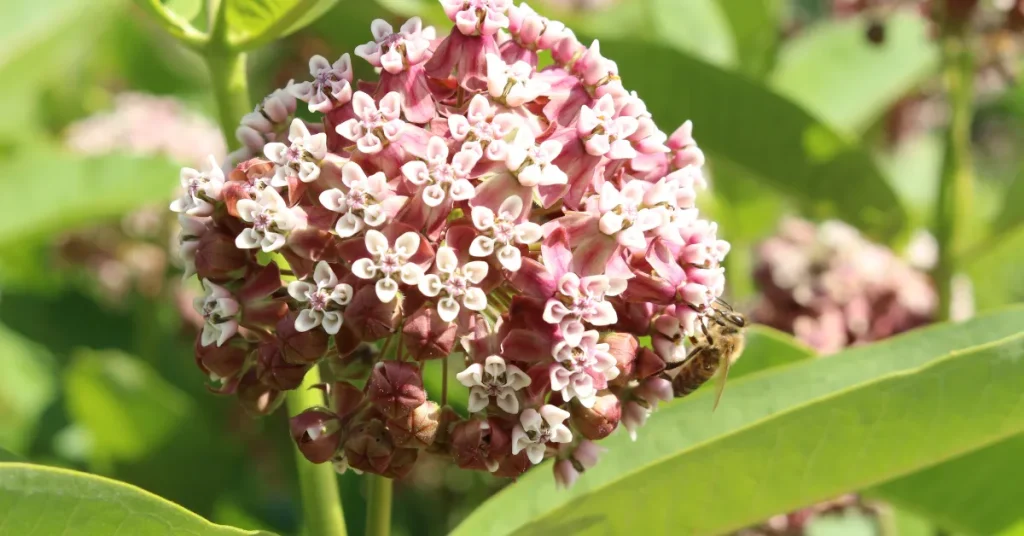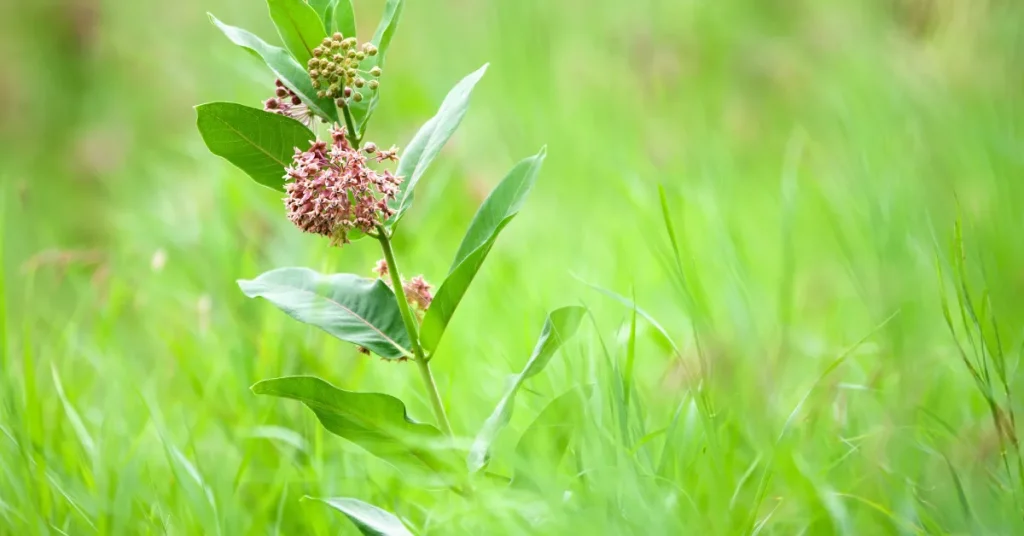Plant milkweed seeds 1/4 inch deep in soil. This depth optimizes germination and root development.
Milkweed planting is a simple but impactful way to support the environment and contribute to the conservation of the monarch butterfly. Milkweed, the sole host plant for monarch caterpillars, plays a critical role in their lifecycle.
By planting milkweed seeds at the correct depth, gardeners ensure successful germination, leading to lush growth that provides essential habitat and nutrition for these pollinators.
A garden rich in milkweed can help bolster the declining monarch population and foster biodiversity. Engaging in milkweed cultivation not only enhances the aesthetic value of your garden but also promotes ecological balance and supports crucial wildlife.

The Importance Of Milkweed For Monarchs
Milkweed plants are more than just wildflowers. They serve as the lifeline for monarch butterflies. These fluttering creatures rely on milkweed for their survival, from larval growth to adulthood.
Let’s delve into how deep to plant these vital seeds and explore their connection with the monarch population.
Monarch Butterflies And Milkweed: A Vital Connection
Monarch butterflies and milkweed share an exclusive relationship. The milkweed plant is the only food source for monarch caterpillars. Without milkweed, the larvae cannot develop into vibrant monarch butterflies. Here’s how they connect:
- Monarch eggs are laid on the underside of milkweed leaves.
- Caterpillars feed solely on milkweed, which provides essential nutrients.
- Milkweed’s sap contains cardenolides, substances that protect monarchs from predators.
The Decline In Milkweed Habitats: Conservation Efforts
Alarmingly, there’s a sharp decline in milkweed habitats. This drop threatens the monarch’s lifecycle. Urban development, agriculture, and herbicide use contribute to habitat loss. These efforts aim to reverse that trend:
- Establishing monarch waystations with milkweed in home gardens.
- Promoting organic farming practices to protect milkweed patches.
- Supporting legislation that favors pollinator conservation.
By planting milkweed, everyone can help safeguard these majestic insects. Properly sowing milkweed seeds gives monarchs the foundations for growth and supports biodiversity.
Choosing The Right Milkweed Species

Successful milkweed planting begins with selecting the appropriate species for your garden. With the right milkweed species, you support local ecosystems and attract monarch butterflies.
Different types adapt to varying climates and soils. Let’s find the perfect match for your environment.
Varieties Of Milkweed: Finding Your Match
Selecting milkweed should be a fun and thoughtful process. Consider attributes like flower color, plant height, and maintenance needs.
- Common Milkweed (Asclepias syriaca): Thrives in most places, with fragrant pink blooms.
- Swamp Milkweed (Asclepias incarnata): Prefers wet soil, sporting white and mauve flowers.
- Butterfly Weed (Asclepias tuberosa): Has vibrant orange blossoms and tolerates dry conditions.
Regional Considerations For Milkweed Planting
Growing milkweed is not a one-size-fits-all situation. Regional climates greatly affect your choice. Farms and gardens flourish when the right species finds its home.
| Region | Recommended Species |
| Northeast | Common Milkweed, Swamp Milkweed |
| Southwest | Butterfly Weed, Antelope Horns |
| Northwest | Showy Milkweed, Narrowleaf Milkweed |
| Southeast | Swamp Milkweed, White Milkweed |
Align your choices with the USDA Plant Hardiness Zone Map to ensure optimal growth. Local nurseries often provide the best species recommendations for your area.
Preparing The Soil For Planting
Preparing the soil before planting milkweed seeds is essential. Good soil fosters healthy milkweed growth. Let’s get your garden ready with the right soil and amendments. This will ensure your milkweed thrives for butterflies to enjoy.
Soil Type And Quality: Getting The Ground Ready
Milkweed prefers well-drained soil to prevent root rot. Use these simple steps to test and prepare your soil:
- Perform a simple soil test. This will tell you what your soil lacks.
- Check for soil drainage by digging a small hole and filling it with water. If water remains after 30 minutes, consider raising your garden bed.
- Clear the planting area of weeds and debris.
- Loosen the soil to about 12 inches deep using a shovel or trowel.
- Mix in organic compost if your soil is heavy clay.
Amendments And Fertilizers: Boosting Milkweed Success
To give your milkweed the best start, provide nutrients with organic amendments:
| Amendment | Benefit |
| Compost | Enriches soil, improves texture |
| Aged Manure | Adds nutrients slowly |
| Bone Meal | Supplies calcium and phosphorus |
- Mix the amendments into the top 6-8 inches of soil.
- Apply a balanced, slow-release fertilizer if the soil test indicates a need.
- Avoid high-nitrogen fertilizers. They can spur leaf growth over flower production.
Planting Milkweed Seeds Correctly
For the monarch butterflies, milkweed is like a cozy home. To help these lovely insects, we must plant milkweed seeds the right way. Find out how deep to bury these seeds, and the best way to arrange them for a butterfly-friendly garden.
Seed Depth Guidelines: How Deep To Plant
Depth matters in planting milkweed seeds. It can mean the difference between seeds that sprout and those that don’t.
| Type of Milkweed | Depth to Plant |
| Common Milkweed | 1/4 inch deep |
| Swamp Milkweed | 1/4 inch deep |
| Butterfly Weed | 1/8 inch deep |
Press the seeds gently into the soil, but do not bury them too deep. Light is essential for their growth.
Spacing And Grouping Strategies For Seedlings
Once your seeds are in place, think about room to grow. Milkweed loves space and friends near! Here’s how to make that happen:
- Space seeds at least 18 inches apart.
- Small groups create a safe place for butterflies.
- Groups of 3 to 6 seeds work best.
- Keep different milkweed types in separate groups.
This gives each plant enough room to spread its roots and leaves. Your milkweed garden will be a butterfly paradise in no time!
Caring For Milkweed Seedlings
Once milkweed seeds find a cozy depth in your garden soil, the next stage begins. Caring for Milkweed Seedlings is vital to help these future butterfly sanctuaries thrive. Keeping them happy involves proper watering and dealing with weeds and pests.
Watering Needs During Germination
Milkweed seedlings love consistent moisture. But remember, they don’t need a flood! Follow these simple steps:
- Keep the soil moist, not soggy, during germination.
- Once seeds sprout, water them gently to avoid damage.
- Reduce watering gradually as seedlings strengthen and grow.
Managing Weeds And Pests In Milkweed Gardens
Weeds and pests can bother your tiny milkweed seedlings. Win the battle with these tricks:
- Pull weeds by hand to keep the area clear.
- Stay away from chemical sprays that can harm milkweed and butterflies.
- Use natural barriers like mulch to stop weeds.
- Watch for pests. Pick them off when you see them.
Maximizing Milkweed Growth

Growing milkweed offers a feast for monarch butterflies. To help these plants thrive, it’s crucial to understand how deep to plant their seeds. Optimal planting methods ensure strong root systems.
These systems support healthy, blooming milkweed. Let’s explore the best practices for maximizing milkweed growth.
Sunlight And Temperature: Creating Ideal Conditions
Milkweed loves the sun. Full sunlight helps these plants grow tall. They need at least six hours of direct sunlight daily.
Consider these tips for sunlight and temperature:
- Plant in sunny spots to maximize growth.
- Avoid shady areas that can stunt plant development.
- Milkweed thrives in temperatures between 70°F and 85°F.
- Use a thermometer to check soil temperature before planting.
Pruning Practices: Encouraging Healthy Plants
Pruning is vital for plant health. It encourages new growth and removes unhealthy parts. Prune milkweed properly to ensure they reach their full potential.
Follow these simple pruning steps:
- Use clean pruning shears to prevent disease spread.
- Cut just above a set of leaves to promote branching.
- Remove dead or yellowing leaves regularly.
- Prune in the spring to stimulate new growth.
Proper pruning results in bushier plants with more flowers. More flowers mean more food for monarchs. It’s a win-win for everyone!
FAQs About How Deep To Plant Milkweed Seeds
How Deep Should Milkweed Seeds Be Sown?
Milkweed seeds are best planted at a depth of 1/8 to 1/4 inch. Cover them lightly with soil, as they require some light to germinate effectively.
What Is The Best Time To Plant Milkweed Seeds?
The ideal time to plant milkweed seeds is in the fall. This allows seeds to naturally stratify over winter. However, spring planting after stratification works well too.
How Often Should Milkweed Be Watered After Planting?
Initially, water milkweed seeds regularly to keep the soil moist. Once established, milkweed is drought-tolerant and requires minimal watering, mostly in prolonged dry spells.
Does Milkweed Need Full Sun To Grow?
Yes, milkweed thrives in full sun exposure. Aim for at least 6 hours of direct sunlight per day for healthy growth and optimal flowering.
Conclusion
Planting milkweed seeds properly promotes monarch butterfly habitats and ensures successful germination. Aim for a depth of 1/4 inch, providing seeds with the right conditions to thrive.
Remember, healthy growth begins with the correct planting depth. So grab your seeds, find a sunny spot, and start contributing to the milkweed revival today!
Resources:
1. https://www.fs.usda.gov/wildflowers/plant-of-the-week/asclepias_syriaca.shtml
